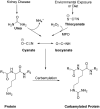Protein carbamylation and chronic kidney disease progression in the Chronic Renal Insufficiency Cohort Study
- PMID: 33661286
- PMCID: PMC8719615
- DOI: 10.1093/ndt/gfaa347
Protein carbamylation and chronic kidney disease progression in the Chronic Renal Insufficiency Cohort Study
Abstract
Background: Protein carbamylation is a post-translational protein modification caused, in part, by exposure to urea's dissociation product cyanate. Carbamylation is linked to cardiovascular outcomes and mortality in dialysis-dependent end-stage kidney disease (ESKD), but its effects in earlier pre-dialysis stages of chronic kidney disease (CKD) are not established.
Methods: We conducted two nested case-control studies within the Chronic Renal Insufficiency Cohort Study. First, we matched 75 cases demonstrating CKD progression [50% estimated glomerular filtration rate (eGFR) reduction or reaching ESKD] to 75 controls (matched on baseline eGFR, 24-h proteinuria, age, sex and race). In the second study, we similarly matched 75 subjects who died during follow-up (cases) to 75 surviving controls. Baseline carbamylated albumin levels (C-Alb, a validated carbamylation assay) were compared between cases and controls in each study.
Results: At baseline, in the CKD progression study, other than blood urea nitrogen (BUN) and smoking status, there were no significant differences in any matched or other parameter. In the mortality group, the only baseline difference was smoking status. Adjusting for baseline differences, the top tertile of C-Alb was associated with an increased risk of CKD progression [odds ratio (OR) = 7.9; 95% confidence interval (CI) 1.9-32.8; P = 0.004] and mortality (OR = 3.4; 95% CI 1.0-11.4; P = 0.05) when compared with the bottom tertile. C-Alb correlated with eGFR but was more strongly correlated with BUN.
Conclusions: Our data suggest that protein carbamylation is a predictor of CKD progression, beyond traditional risks including eGFR and proteinuria. Carbamylation's association with mortality was smaller in this limited sample size.
Keywords: CKD; carbamylation; mortality; progression; urea.
© The Author(s) 2020. Published by Oxford University Press on behalf of ERA-EDTA. All rights reserved.
Figures





Comment in
-
New clinical evidence for urea toxicity.Nephrol Dial Transplant. 2021 Dec 31;37(1):1-4. doi: 10.1093/ndt/gfab269. Nephrol Dial Transplant. 2021. PMID: 34519782 No abstract available.
References
Publication types
MeSH terms
Grants and funding
- K24 DK092290/DK/NIDDK NIH HHS/United States
- UL1 TR002548/TR/NCATS NIH HHS/United States
- U01 DK060963/DK/NIDDK NIH HHS/United States
- U01 DK103225/DK/NIDDK NIH HHS/United States
- UL1 RR024131/RR/NCRR NIH HHS/United States
- U01 DK061022/DK/NIDDK NIH HHS/United States
- R01 DK119199/DK/NIDDK NIH HHS/United States
- UL1 TR000003/TR/NCATS NIH HHS/United States
- UL1 TR000439/TR/NCATS NIH HHS/United States
- U01 DK060990/DK/NIDDK NIH HHS/United States
- P30 DK114857/DK/NIDDK NIH HHS/United States
- U01 DK061028/DK/NIDDK NIH HHS/United States
- UL1 TR000433/TR/NCATS NIH HHS/United States
- R56 HL133399/HL/NHLBI NIH HHS/United States
- R01 HL133399/HL/NHLBI NIH HHS/United States
- U01 DK060984/DK/NIDDK NIH HHS/United States
- U01 DK061021/DK/NIDDK NIH HHS/United States
- U24 DK060990/DK/NIDDK NIH HHS/United States
- U01 DK060980/DK/NIDDK NIH HHS/United States
- R01 DK124453/DK/NIDDK NIH HHS/United States
- K23 DK128567/DK/NIDDK NIH HHS/United States
- UL1 TR000424/TR/NCATS NIH HHS/United States
- M01 RR016500/RR/NCRR NIH HHS/United States
- P20 GM109036/GM/NIGMS NIH HHS/United States
- U01 DK060902/DK/NIDDK NIH HHS/United States
- K08 HL121801/HL/NHLBI NIH HHS/United States
- K23 DK120811/DK/NIDDK NIH HHS/United States
- K23 DK106479/DK/NIDDK NIH HHS/United States
- UL1 RR029879/RR/NCRR NIH HHS/United States
LinkOut - more resources
Full Text Sources
Medical
Research Materials
Miscellaneous

